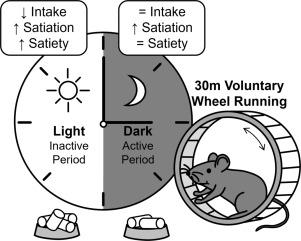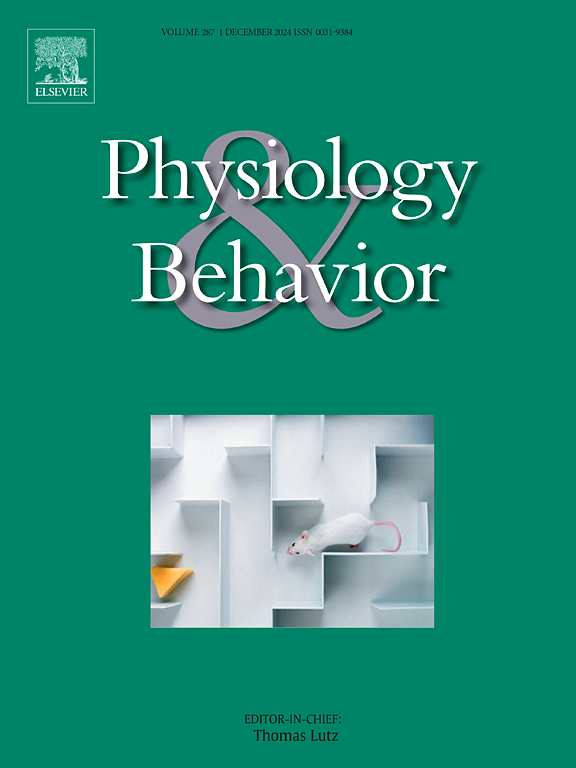在小鼠的光-暗周期中,自愿运动改变了高脂肪食物的摄入和膳食结构。
IF 2.5
3区 医学
Q2 BEHAVIORAL SCIENCES
引用次数: 0
摘要
摄入高脂肪食物的时机对代谢健康很重要,在不活动阶段摄入高脂肪食物会增加体重增加和肥胖的风险。虽然运动可以帮助恢复被打乱的昼夜节律进食模式,但它对光-暗循环中高脂肪食物摄入和膳食结构的影响尚不清楚。这项研究调查了每天短暂的自愿运动如何影响高脂肪食物的摄入和饮食结构。在黑暗(活动)期间,每天给小鼠30分钟的跑步轮,并自由获取高脂肪食物。分别分析光照期和黑暗期的摄取量和膳食结构。在光照期,运动选择性地减少了食物摄入量,而在黑暗期则没有变化。运动小鼠也花更少的时间吃饭,吃得更少、更短,在清淡期表现出更高的饱腹率。在黑暗期,运动小鼠吃得更少,但吃得更频繁。这些发现表明,日常运动促进了在光-暗周期中更早的用餐结束(饱腹感),但只在光周期中改善了两餐之间的持续饱腹感(饱腹感)。通过将食物摄入从清淡(不活跃)阶段转移,运动可以帮助抵消与体重增加相关的不健康饮食习惯。了解运动如何与昼夜进食行为相互作用对于优化基于运动的策略以改善代谢健康和食欲调节至关重要。本文章由计算机程序翻译,如有差异,请以英文原文为准。

Voluntary exercise alters high-fat food intake and meal structure across the light-dark cycle in mice
The timing of high-fat food intake is important for metabolic health, with consumption during the inactive phase increasing the risk of weight gain and obesity. While exercise can help restore disrupted circadian feeding patterns, its influence on high-fat food intake and meal structure across the light-dark cycle remains less understood. This study examined how brief, daily voluntary exercise affects high-fat food intake and meal structure across the light and dark periods. Mice were given 30 min of running wheel access each day during the dark (active) period and had ad libitum access to high-fat food. Intake and meal structure were analyzed separately for the light and dark periods. Exercise selectively reduced food intake during the light period, with no change during the dark period. Exercise mice also spent less time eating, had smaller and shorter meals, and exhibited an improved satiety ratio during the light period. In the dark period, exercise mice ate smaller meals but compensated by eating more frequently. These findings suggest that daily exercise promotes earlier meal termination (satiation) across the light-dark cycle but improves sustained fullness between meals (satiety) only during the light period. By shifting food intake away from the light (inactive) phase, exercise may help counteract unhealthy feeding habits associated with weight gain. Understanding how exercise interacts with circadian feeding behaviors is crucial for optimizing exercise-based strategies to improve metabolic health and appetite regulation.
求助全文
通过发布文献求助,成功后即可免费获取论文全文。
去求助
来源期刊

Physiology & Behavior
医学-行为科学
CiteScore
5.70
自引率
3.40%
发文量
274
审稿时长
47 days
期刊介绍:
Physiology & Behavior is aimed at the causal physiological mechanisms of behavior and its modulation by environmental factors. The journal invites original reports in the broad area of behavioral and cognitive neuroscience, in which at least one variable is physiological and the primary emphasis and theoretical context are behavioral. The range of subjects includes behavioral neuroendocrinology, psychoneuroimmunology, learning and memory, ingestion, social behavior, and studies related to the mechanisms of psychopathology. Contemporary reviews and theoretical articles are welcomed and the Editors invite such proposals from interested authors.
 求助内容:
求助内容: 应助结果提醒方式:
应助结果提醒方式:


